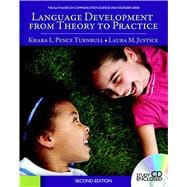
Note: Supplemental materials are not guaranteed with Rental or Used book purchases.
Purchase Benefits
Brief Contents
Chapter 1 Language Development: An Introduction
Chapter 2 The Science and Theory of Language Development
Chapter 3 Building Blocks of Language
Chapter 4 Neuroanatomy and Neurophysiology of Language
Chapter 5 Infancy: Let the Language Achievements Begin
Chapter 6 Toddlerhood: Exploring the World and Experimenting with Language
Chapter 7 Preschool: Building Literacy on Language
Chapter 8 School-Age Years and Beyond: Developing Later Language
Chapter 9 Language Differences and Disorders
Glossary
References
Subject and Name index
Contents
1
Focus Questions
Important Terms
What Is Language?
Language Defined
Language as a Module of Human Cognition
How Does Language Relate to Speech, Hearing, and Communication?
Speech
Hearing
Communication
What Are the Major Domains of Language?
Form, Content, and Use
Components of Form, Content, and Use
What Are Some Remarkable Features of Language?
Acquisition Rate
Universality
Species Specificity
Semanticity
Productivity
What Are Language Differences and Language Disorders?
Language Differences
Language Disorders
Summary
2
Focus Questions
Important Terms
Who Studies Language Development and Why?
Basic Research
Applied Research
What Are Some Major Approaches to Studying Language Development?
Approaches to Studying Speech Perception
Approaches to Studying Language Production
Approaches to Studying Language Comprehension
What Are Some Major Language Development Theories?
Questions That Should Be Answered by Language Theories
Major Language Development Theories
How Do Language Development Theories Influence Practice?
Linkage of Theory to Practice
Instruction in English as a Second Language: Theory and Practice
Practices Informed by Language Theories
Evidence-Based Practice: Linking Theory, Science, and Practice
Summary
3
Focus Questions
Important Terms
What Is Phonological Development?
Phonological Building Blocks
Influences on Phonological Development
What Is Morphological Development?
Morphological Building Blocks
Influences on Morphological Development
What Is Syntactic Development?
Syntactic Building Blocks
Influences on Syntactic Development
Influences on Syntactic Development
What Is Semantic Development?
Semantic Building Blocks
Influences on Semantic Development
What Is Pragmatic Development?
Pragmatic Building Blocks
Influences on Pragmatic Development
Summary
4
Focus Questions
Important Terms
What Are Neuroanatomy and Neurophysiology?
Terminology
Neuroscience Basics
What Are The Major Structures And Functions Of The Human Brain?
Cerebrum
Brainstem
Cerebellum
How Does the Human Brain Process and Produce Language?
Semantics
Syntax and Morphology
Phonology
Pragmatics
What Are Neurophysiological and Neuroanatomical Sensitive Periods?
Sensitive Periods Defined
Neuroanatomical and Neurophysiological Concepts Related to Sensitive Periods
Sensitive Periods and Language Acquisition
Summary
5
Focus Questions
Important Terms
What Major Language Development Milestones Occur in Infancy?
Infant Speech Perception
Awareness of Actions and Intentions
Category Formation
Early Vocalizations
Additional Milestones
What Are Some of the Early Foundations for Language Development?
Infant-Directed Speech
Joint Reference and Attention
Daily Routines of Infancy
Caregiver Responsiveness
What Major Achievements in Language Form, Content, and Use Characterize Infancy?
Language Form
Language Content
Language Use
What Factors Influence Infants’ Individual Achievements in Language?
Intraindividual Differences
Interindividual Differences
How Do Researchers and Clinicians Measure Language Development in Infancy?
Researchers
Clinicians
Summary
6
Focus Questions
Important Terms
What Major Language Development Milestones Occur in Toddlerhood?
First Words
Gestures
What Major Achievements in Language Form, CONTENT, and Use Characterize Toddlerhood?
Language Form
Language Content
Language Use
What Factors Influence Toddlers’ Individual Achievements in Language?
Intraindividual Differences
Interindividual Differences
How Do Resesarchers and Clinicians Measure Language Development in Toddlerhood?
Researchers
Clinicians
Summary
7
Focus Questions
Important Terms
What Major Language Development Milestones Occur in the Preschool Period?
Decontextualized Language
Emergent Literacy
What Major Achievements in Language Content, Form, and Use Characterize the Preschool Period?
Language Form
Language Content
Language Use
What Factors Influence Preschoolers’ Individual Achievements in Language?
Intraindividual Differences
Interindividual Differences
How Do Researchers and Clinicians Measure Language Development in the Preschool Period?
Researchers
Clinicians
Summary
8
Focus Questions
Important Terms
What Major Language Development Milestones Occur in the School-Age Years and Beyond?
Shifting Sources of Language Input
Acquisition of Metalinguistic Competence
What Major Achievements in Language Content, Form, and Use Characterize the School-Age Years and Beyond?
Language Form
Language Content
Language Use
What Factors Influence School-Age Children’s, Adolescents’, and Adults’ Individual Competencies in Language?
Language and Gender
Language and Aging
How Do Researchers and Clinicians Measure Language Development in the School-Age Years and Beyond?
Assessment Types
Assessment of Language Form
Assessment of Language Content
Assessment of Language Use
Summary
9
Focus Questions
important terms
WHAT ARE DIALECTSWhat are?
Dialects
Pidgins
Creoles
What Are Bilingualism and Second Language Acquisition?
Bilingualism and Multilingualism
Second Language Acquisition
What Is a Language Disorder?
Distinguishing Between Language Disorders and Language Differences
Prevalence
What Are The Major Types of Child Language Disorders?
Specific Language Impairment
Autism Spectrum Disorder
Intellectual Disability
Traumatic Brain Injury
Hearing Loss
Identification and Treatment of Language Disorders
Summary
G lossary
References
The New copy of this book will include any supplemental materials advertised. Please check the title of the book to determine if it should include any access cards, study guides, lab manuals, CDs, etc.
The Used, Rental and eBook copies of this book are not guaranteed to include any supplemental materials. Typically, only the book itself is included. This is true even if the title states it includes any access cards, study guides, lab manuals, CDs, etc.